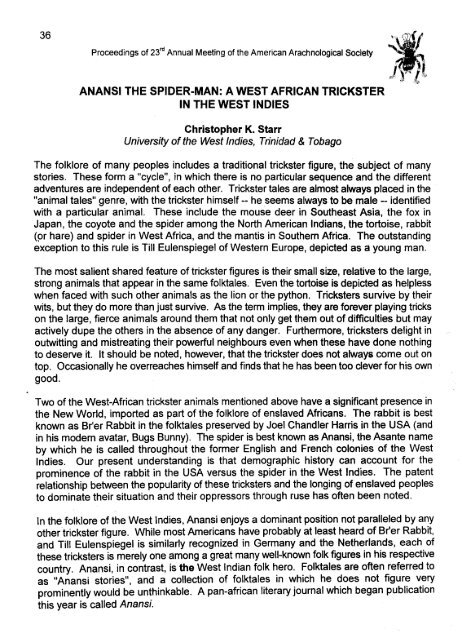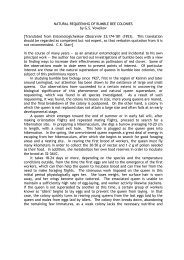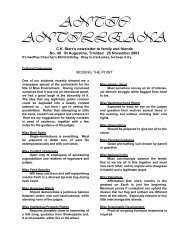ANANSI THE SPIDER-MAN: A WEST AFRICAN ... - ckstarr.net
ANANSI THE SPIDER-MAN: A WEST AFRICAN ... - ckstarr.net
ANANSI THE SPIDER-MAN: A WEST AFRICAN ... - ckstarr.net
You also want an ePaper? Increase the reach of your titles
YUMPU automatically turns print PDFs into web optimized ePapers that Google loves.
36<br />
)l' [t<br />
}
~"'I" L~I Proceedings of 23" Annual Meeting of the American Arachnological Society<br />
.1l }'~.<br />
. "'';;:>;<br />
Anansi continues to be the subject of new stories, some of them true folktales and others<br />
originating in as published literary works by named authors. To a West Indian, there is<br />
nothing incongruous about a story in which Anansi and his family ride in a car, go to the<br />
supermarket, play cricket or even use a computer.<br />
My research into the comparative folklore of trickster tales has given rise to two<br />
hypotheses, each applicable to Anansi.<br />
The first is that animal trickster figures undergo a progressive humanization. This is by no<br />
means an original idea. It seems, in fact, to have the status of a vague conventional<br />
wisdom in folktale research. However, I am not aware that it has yet been tested or even<br />
closely examined. The considerable variation in Anansi's spiderness/humanity between<br />
stories and versions is readily apparent. It is also seen in the various published illustrations<br />
of Anansi, which range from entirely spider-like to entirely human. Our conference logo<br />
was commissioned to represent the middle range of this continuum, in which Anansi has<br />
some spider and some human features, a true spider-man.<br />
However, it is by no means proven that this variation represents a historical progression,<br />
such that over time the spider features are more· and more de-emphasized. The<br />
hypothesis, then, is easy to pose and in principle testable, but formulation of a satisfactory<br />
scientific test continues to be a problem.<br />
The second hypothesis is somewhat bolder and has to the do with the relationship between<br />
peoples, their traditional trickster figures, and the exploits of these tricksters. Arising out<br />
of a remark in Walter Jekyll's classic treatment of the folklore of Jamaica, it is hypothesized<br />
that folklore will at once show extreme conservatism in the identity of the trickster figure<br />
and great adaptability in the particular stories associated with him.<br />
Preliminarily, this hypothesis seems well corroborated. Especially among traditional<br />
peoples, trickster exploits are attributed to consistent figures. However, where two<br />
neighbouring peoples have very different trickster figures, as a rule many of the same<br />
stories are told about each. It is even plausible that, where a trickster figure is the subject<br />
of an apparently unique story, this is in fact due to uneven collecting by folklorists.<br />
The most striking observation in favour of this second hypothesis is those stories that show<br />
up in the folklore of widely dispersed peoples, many of whom would appear to have very<br />
little social contact with each other. The famous story of Brier Rabbit and Tar Baby, for<br />
example, appears in clearly homologous versions not only among various peoples of West<br />
Africa but as far afield as Asia and among the Indians of North America.<br />
The hypothesis of the immobility of trickster figures combined with extreme vagility of their<br />
exploits, if demonstrated, seems likely to be a general principle of folklore. In the<br />
meantime, it provides me with a convenient scholarly pretext to delectate the adventures<br />
and foibles of Anansi, the West Indian spider-man.<br />
37








